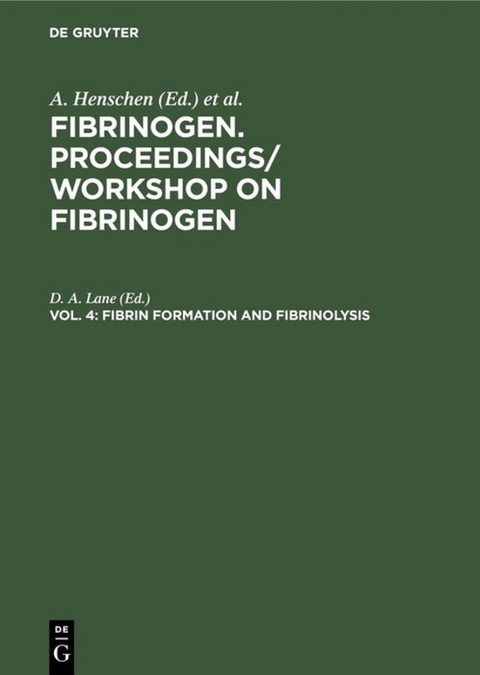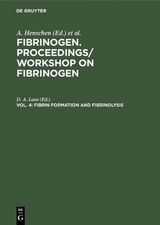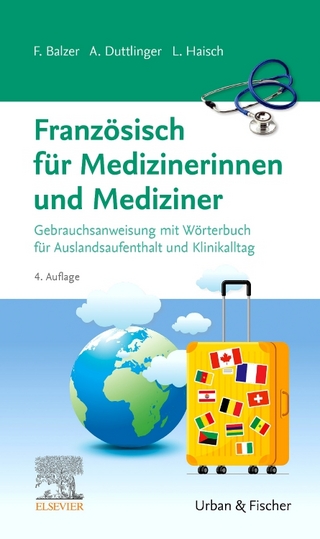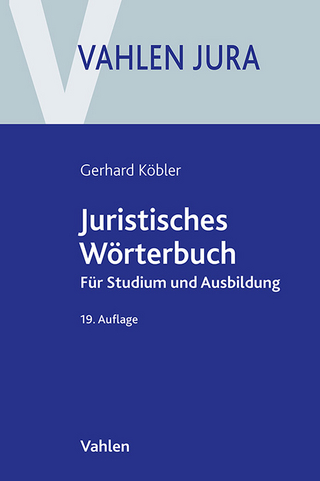Fibrinogen. Proceedings/ Workshop on Fibrinogen / Fibrin formation and Fibrinolysis
De Gruyter (Verlag)
978-3-11-010597-1 (ISBN)
Frontmatter -- Preface -- Contributors -- Contents -- I. Synthesis And Assembly -- A scheme for the intracellular assembly of human fibrinogen -- Evidence that platelet and plasma fibrinogen have the same A-alpha chain gene product -- Fibrinopeptide A and the phosphorylation of fibrinogen -- II. Structure and Function -- Size and shape of the fibrinogen molecule: crystalline forms of native and modified human fibrinogen -- The C-terminal polymerisation domain of fibrinogen -- ?- Chain Crosslinking Of Fibrin At Dd-Trans Contact -- Soluble fibrin contains fibrin polymers of different molecular weight. Ultracentrifugation studies at 37°C -- Relationship of final thickness of fibrin fibers to maximal rate of assembly and to fibrinopeptide B release -- III. Congenital Variants -- Fibrinogen New York 1: The structural, functional, and genetic defects and an hypothesis of the role of fibrin in the regulation of coagulation and fibrinolysis -- Fibrinogen Pontoise - a genetically abnormal fibrinogen with defective fibrin polymerisation but normal fibrinopeptide release -- Fibrinogen Milano I: Abnormal fibrin polymerization related to a carboxy-terrainal defect of the ?-chain (?-330 Asp Val) -- Fibrinogen "Bergamo I" (?? 16 Arg - Cys): Alternative methods for structure elucidation -- Screening small plasma samples by HPLC for abnormalities of fibrinopeptide release -- Iv. Fibrin(ogen) And Fibrinolysis -- On the role of fibrin in the fibrinolytic system -- Isolation and characterisation of plasmic degradation products of fibrinogen by high-performance liquid chromatography -- The acceleration of tissue-type plasminogen activator (t-PA)-mediated activation of plasminogen by fibrinogen cyanogen bromide fragments is species specific -- Role of fibrin polymerization in fibrinolysis: Comparison between polymerisable and unpolymerisable fibrins in the potentiating effect of plasminogen activation by tissue-type plasminogen activator (tpA) -- Role of fibrin and its degradation products in the activation of plasminogen by streptokinase and urokinase -- V. Interactions With Cells -- The role of fibrinogen in platelet aggregation -- Platelet-associated fibrinogen: Conformational change of fibrinogen induced by its adsorption to platelet-surface -- Migration of cultured endothelial cells in response to fibrinogen -- Characteristics of the interactions of fibrinogen and soluble fibrin with cultured endothelial cells -- Mechanism of fibrin-induced disorganisation of cultured human endothelial cells -- The fibrinogen: red cell interaction and its influence on blood rheology -- Haemorheologic effects of plasmin and thrombininduced fibrinogen derivatives: An in vitro study -- Binding of human fibrinogen to streptococci and its role in streptococcal pathogenicity -- VI. Assays To Fibrin(ogen) Fragments And Their Use -- Discrimination between fibrin and fibrinogen by a monoclonal antibody against a synthetic hexapeptide representing the amino-terminus of the alpha-chain of fibrin -- A new enzyme immunoassay of fibrin(ogen) degradation products in plasma using a monoclonal antibody -- Fibrin(ogen) degradation products. Determination using a monoclonal anti D neo antibody. Advantages in clinical investigation -- A monoclonal antibody, specific for human fibrinogen and fibrinopeptide A-containing fragments. Its application in an enzyme-immunoassay for fibrinogen degradation products, suitable for use in plasma -- A monoclonal antibody against the CNBr-peptide F-CB3 of the A?-chain of human fibrinogen -- Clinical aspects of fibrin formation and fibrinolysis measured with monoclonal antibodies against D-dimer -- Fibrinogen derivatives in acute stroke -- VII. Fibrin(ogen) And Disease Pathology -- Triggering of the extrinsic blood coagulation system -- Extravascular fibrin formation and fibrinolysis in a model of inflammation accompanying cellular hypersensitivity -- Extra-vascular fibrin deposition in cellular hypersensitivity - the role of T lymphocyte-macrop
Frontmatter -- Preface -- Contributors -- Contents -- I. Synthesis And Assembly -- A scheme for the intracellular assembly of human fibrinogen -- Evidence that platelet and plasma fibrinogen have the same A-alpha chain gene product -- Fibrinopeptide A and the phosphorylation of fibrinogen -- II. Structure and Function -- Size and shape of the fibrinogen molecule: crystalline forms of native and modified human fibrinogen -- The C-terminal polymerisation domain of fibrinogen -- ?- Chain Crosslinking Of Fibrin At Dd-Trans Contact -- Soluble fibrin contains fibrin polymers of different molecular weight. Ultracentrifugation studies at 37°C -- Relationship of final thickness of fibrin fibers to maximal rate of assembly and to fibrinopeptide B release -- III. Congenital Variants -- Fibrinogen New York 1: The structural, functional, and genetic defects and an hypothesis of the role of fibrin in the regulation of coagulation and fibrinolysis -- Fibrinogen Pontoise - a genetically abnormal fibrinogen with defective fibrin polymerisation but normal fibrinopeptide release -- Fibrinogen Milano I: Abnormal fibrin polymerization related to a carboxy-terrainal defect of the ?-chain (?-330 Asp Val) -- Fibrinogen "Bergamo I" (?? 16 Arg - Cys): Alternative methods for structure elucidation -- Screening small plasma samples by HPLC for abnormalities of fibrinopeptide release -- Iv. Fibrin(ogen) And Fibrinolysis -- On the role of fibrin in the fibrinolytic system -- Isolation and characterisation of plasmic degradation products of fibrinogen by high-performance liquid chromatography -- The acceleration of tissue-type plasminogen activator (t-PA)-mediated activation of plasminogen by fibrinogen cyanogen bromide fragments is species specific -- Role of fibrin polymerization in fibrinolysis: Comparison between polymerisable and unpolymerisable fibrins in the potentiating effect of plasminogen activation by tissue-type plasminogen activator (tpA) -- Role of fibrin and its degradation products in the activation of plasminogen by streptokinase and urokinase -- V. Interactions With Cells -- The role of fibrinogen in platelet aggregation -- Platelet-associated fibrinogen: Conformational change of fibrinogen induced by its adsorption to platelet-surface -- Migration of cultured endothelial cells in response to fibrinogen -- Characteristics of the interactions of fibrinogen and soluble fibrin with cultured endothelial cells -- Mechanism of fibrin-induced disorganisation of cultured human endothelial cells -- The fibrinogen: red cell interaction and its influence on blood rheology -- Haemorheologic effects of plasmin and thrombininduced fibrinogen derivatives: An in vitro study -- Binding of human fibrinogen to streptococci and its role in streptococcal pathogenicity -- VI. Assays To Fibrin(ogen) Fragments And Their Use -- Discrimination between fibrin and fibrinogen by a monoclonal antibody against a synthetic hexapeptide representing the amino-terminus of the alpha-chain of fibrin -- A new enzyme immunoassay of fibrin(ogen) degradation products in plasma using a monoclonal antibody -- Fibrin(ogen) degradation products. Determination using a monoclonal anti D neo antibody. Advantages in clinical investigation -- A monoclonal antibody, specific for human fibrinogen and fibrinopeptide A-containing fragments. Its application in an enzyme-immunoassay for fibrinogen degradation products, suitable for use in plasma -- A monoclonal antibody against the CNBr-peptide F-CB3 of the A?-chain of human fibrinogen -- Clinical aspects of fibrin formation and fibrinolysis measured with monoclonal antibodies against D-dimer -- Fibrinogen derivatives in acute stroke -- VII. Fibrin(ogen) And Disease Pathology -- Triggering of the extrinsic blood coagulation system -- Extravascular fibrin formation and fibrinolysis in a model of inflammation accompanying cellular hypersensitivity -- Extra-vascular fibrin deposition in cellular hypersensitivity - the role of T lymphocyte-macrop
| Erscheint lt. Verlag | 1.3.1986 |
|---|---|
| Reihe/Serie | Fibrinogen. Proceedings/ Workshop on Fibrinogen ; Vol. 4 |
| Zusatzinfo | Num. figs. |
| Verlagsort | Berlin/Boston |
| Sprache | deutsch |
| Maße | 155 x 230 mm |
| Gewicht | 899 g |
| Themenwelt | Schulbuch / Wörterbuch ► Lexikon / Chroniken |
| Schlagworte | Allgemein • biochemistry • Fibrin • Fibrinogen • General • General Interest • Lexika, Nachschlagewerke • Medical • Reference |
| ISBN-10 | 3-11-010597-7 / 3110105977 |
| ISBN-13 | 978-3-11-010597-1 / 9783110105971 |
| Zustand | Neuware |
| Haben Sie eine Frage zum Produkt? |
aus dem Bereich




